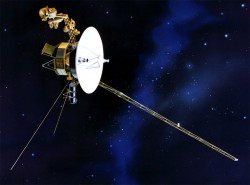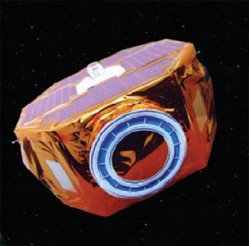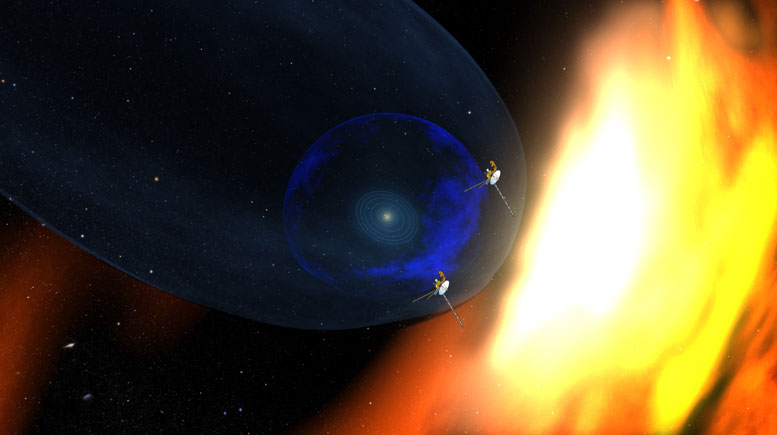[/caption]
Space is far from empty. The Solar System can be viewed as a “bubble” of solar matter – filled with particles emitted by the Sun as the solar wind – extending well beyond the orbit of Pluto. The solar wind velocity is supersonic for most of this distance (exceeding a million miles per hour), but the point at which it begins to interact with the interstellar medium (ISM), the solar wind drops to subsonic velocities, creating a region of compression known as the termination shock. After 26 years of flight, the Voyager 1 deep space probe entered this bizarre, turbulent region of space, where solar particles build up and magnetic fields become twisted. Now a new mission has been designed to watch this region of space from afar to begin to understand the boundary of our solar system, where violent turbulence rules and high-energy atoms are generated…
In 2004, Voyager 1 hit it and in 2006, Voyager 2 hit it. The first probe flew through the termination shock at around 94 AU (8 billion miles away); the second measured it at only 76 AU (7 billion miles). This result alone suggests that the termination shock may be irregularly shaped and/or variable depending on solar activity. Before the Voyager missions, the termination shock was theorized, but there was little observational evidence until the two veteran probes traversed the region. The termination shock is of paramount importance to understanding the nature of the outer reaches of the solar system as, counter-intuitively, the Sun’s activity increases, the region beyond the termination shock (the heliosheath) becomes more efficient at blocking deadly cosmic rays. During solar minimum, it becomes less efficient at blocking cosmic rays.

In an effort to map the location and characteristics of the termination shock and heliosheath beyond, NASA scientists are preparing the Interstellar Boundary Explorer (IBEX) for launch in October. IBEX is part of NASA’s Small Explorer program (SMEX), where inexpensive, small probes are used to efficiently observe particular cosmic phenomena. IBEX will be orbiting beyond the influence of the Earth’s magnetic field (the magnetosphere) at a 200,000 mile distance from the Earth. This is because the phenomenon IBEX will be observing can be generated by our own magnetic field. So what will IBEX be measuring? To understand the interaction between solar wind ions and the interstellar medium, IBEX will use two sensors to detect energetic neutral atoms (ENAs) being blasted from the outermost reaches of the solar system.
How are ENAs generated and how are they a measurement of the interaction between the heliosphere and the ISM? Out there in the ISM exists neutral atoms and ions. As the solar system passes through interstellar space, the strong magnetic field generated around the heliosphere deflects the charged ions, pushing them out of the way. However, slow-moving neutral atoms are not affected by the magnetic field and penetrate deep into the heliosheath. When this happens, these neutral atoms from the ISM interact with energetic protons (which do have charge) rapidly spiralling along the magnetic field embedded in the solar wind. When this interaction occurs (known as charge exchange), an electron is stripped from the ISM atom and attracted to the energetic solar wind proton, thus making it neutral. When this exchange occurs, an energetic hydrogen atom (electron and proton) is ejected. An ENA is born.

Now, this is where the clever bit comes in. As mentioned before, neutral atoms do not “feel” magnetic fields, so when ENAs are created they are ejected in a straight line. Some of these atoms will be directed toward the Earth. IBEX will then measure these ENAs and work out where they came from. As they will have travelled directly to IBEX, the location of the termination shock may be deduced. Over a period of time, IBEX will be able to build up a picture of the locations of these atomic interactions and relate them the characteristics of the boundary of our Solar System.
But the best thing is, we won’t need to send a probe into deep space and wait for decades before it traverses the boundary layer, we will be able to make these measurements from Earth orbit. Such an exciting mission. Roll on the Pegasus rocket launch October 5th, 2008!
Source: Physorg.com


These are the particles detected by SOHO, right? (Or was it Ulysses? I forget.) Fascinating to see so short a turnaround from discovery to investigation.
What sort of detectors will be able to register the trajectory of neutral atoms?
I don’t understand why the difference between super- and subsonic is so important. After all, in space no one can hear you scream etc. Does it mean the speed of sound in a pretty-close-to-vacuum environment? Where sound doesn’t really travel? What is that speed anyway?
Anybody?
I’ve always found the termination shock and the heliopause fascinating from a physics point of view. It is great that they have devised a mission capable of making significant strides forward in our knowledge of this enigmatic region of our solar system for a bargain-basement price.
# kvenlander Says:
July 27th, 2008 at 6:06 pm
“I don’t understand why the difference between super- and subsonic is so important. After all, in space no one can hear you scream etc. Does it mean the speed of sound in a pretty-close-to-vacuum environment? Where sound doesn’t really travel? What is that speed anyway?
Anybody?”
>>>The interest in the supersonic to subsonic transition has less to do with sound and more to do with the physics that accompanies it.
When the flow of particles from the Sun transitions from supersonic to subsonic, a shockwave forms – much as a shockwave forms here on Earth when a plane transitions from subsonic to supersonic. The point at which this occurs in terms of our solar system is called the ‘termination shock’, and all kinds of interesting physics happens there. For example, magnetic fields are warped, you get compression and heating effects taking place in the plasma, etc.
Tentative numbers for the supersonic flow emitted by the sun are ~400 Km/s near the Sun, and the supersonic/subsonic transition happens at about 100 Km/s relative to the Sun.
As far as your questions on whether sound can travel in the near vacuum found there – though the plasma is tenuous we can still define a speed of sound there – this is usually done in terms of some slightly obscure physics. Though this speed of sound has little to do with actually ‘hearing’ anything, shockwaves can still propagate through the plasma medium in a similar way to how sound travels through air.
This is a very nice mission concept which may yield some very interesting and unexpected findings. It should be worth every penny spent on it.
we have internet, nanotechnology thing but still stuck here on earth
those missions are going nowhere
and again its all about money !
You want money?–Try tying in with Defence, or reducing Defence spending. In a peaceful world, much more will be attempted and achieved. But then we might have a dreadful population explosion, or for a while, anyway. Money and science won’t get us out of that. Too many people = too many people for us to cater for and for this world to support without dreadful consequences.